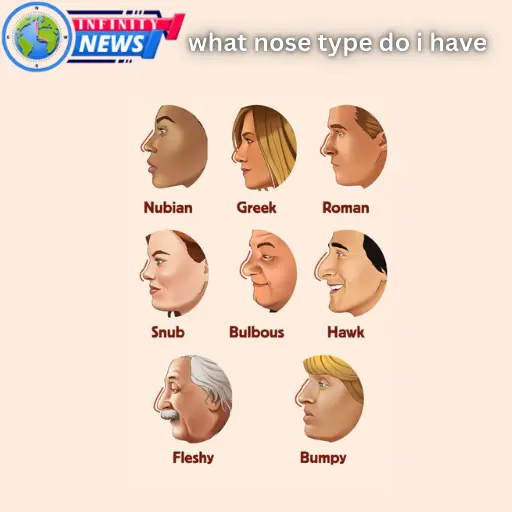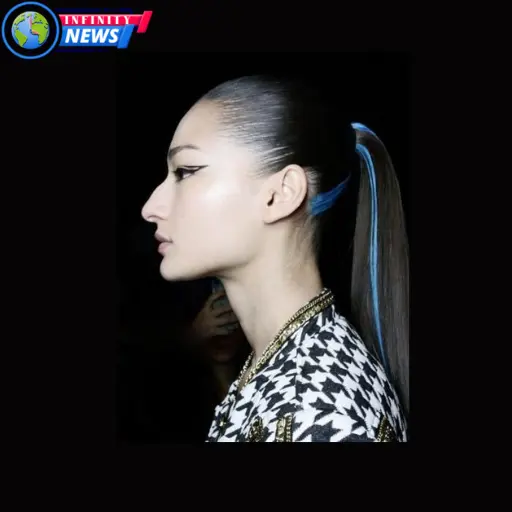Introduction
Have you ever looked in the mirror and wondered, “What nose type do I have?” You’re not alone. Many people are curious about their nose shape not just for looks, but because it can reflect aspects of aesthetics, heritage, and even personality.

There are many different types of noses, and each one adds something unique to your face. Some people search for the most common nose shapes out of curiosity, while others are interested in nose shape and personality or how their ethnic background may have influenced their features.
Understanding your nose type can also help if you’re thinking about cosmetic nose surgery or non-surgical options. Knowing whether you have a Roman nose, button nose, or something in between can be useful when exploring rhinoplasty options or simply learning to appreciate your own facial structure.
A Quick Look at Nose Shapes And Why We Care
Nose shapes are as unique as fingerprints. From the sharp lines of a Roman nose to the soft curves of a button nose, the variety is endless. People often wonder, “What nose type do I have?” not just out of curiosity, but because nose shape can influence how we see ourselves and how others perceive us.
Your nose sits at the center of your face, playing a major role in facial harmony and overall appearance. It’s no surprise that many are drawn to learning more about different nose shapes, especially when considering beauty standards, ethnic identity, or even personality insights.
Some are curious about how their nose shape reflects their heritage, while others are exploring rhinoplasty options and want to understand the structure they’re working with. Whether you’re simply interested in the most common nose types, or want to take a fun nose shape personality test, getting to know your own features is a powerful way to connect with your identity—and feel more confident in the process.
Nose Shape, Aesthetics, Heritage, and Personality: What It All Means
Your nose shape does more than just define your profile it can reflect deeper parts of who you are. From an aesthetic point of view, the nose contributes to facial balance and symmetry, both of which are often associated with attractiveness. People looking into what nose type they have are often curious about how their nose fits into common beauty standards or if it enhances their overall appearance.
Beyond looks, your nose shape may be influenced by heritage. Different ethnic backgrounds are often associated with specific nose traits such as wider bridges, curved dorsums, or narrow tips. These variations are natural markers of ancestry and evolution, giving every face its unique story.
Some even believe that your nose shape can reveal personality traits. While not scientifically proven, many enjoy exploring the idea that a straight, sharp nose hints at leadership or that a soft, rounded nose suggests kindness.
Why Does Nose Shape Matter?
Your nose does more than just help you breathe.it plays a big role in how your face looks and feels. Understanding your nose type helps you appreciate your facial harmony and unique features. When people ask, “What nose type do I have?” they’re often curious about how their nose shape fits their overall appearance or how it might compare to different types of noses around the world.
From a scientific view, the structure of your nose can influence balance, symmetry, and even first impressions. Some believe your nose shape reveals personality traits, while others are simply curious about the most common nose shapes and how to identify their nose type at home.
Across cultures and ethnic backgrounds, nose shapes by ethnicity show just how diverse human features are. Whether you’re exploring this out of curiosity or considering rhinoplasty options, knowing your nose shape can be both fun and empowering.
In the next section, we’ll explore the 14 most common nose types and help you see exactly where yours fits in.
The 14 Most Common Nose Types
Nose shapes vary widely across individuals and cultures. Here are the 14 most common nose types that you may recognize:
Roman Nose
The Roman nose is one of the most distinct and classic nose shapes, known for its straight bridge and well-defined profile. This type of nose typically features a prominent, slightly curved or straight bridge that protrudes from the face, giving it a strong, noble appearance.

Historically, the Roman nose was admired in classical art and sculpture, often seen as a symbol of leadership and strength. It’s common in many Mediterranean populations and is associated with a sense of sophistication and power. People with this nose shape may have a high, straight bridge, which provides a sharp contrast to a softer, rounder tip.
A Roman nose can be a striking feature, adding balance to the face by creating a sense of symmetry. It’s often considered highly attractive for its bold, sculptural quality. While the Roman nose may appear strong, it also carries elegance, making it a symbol of grace and beauty in many cultures.
Greek Nose
The Greek nose is often considered the epitome of classic beauty due to its refined and straight shape. Characterized by a smooth, straight bridge that flows seamlessly from the forehead to the tip, this nose type creates a balanced and proportional appearance. It is one of the most sought-after nose shapes for its symmetry and subtle elegance.

The Greek nose is typically slender and does not feature a prominent bump or curve, unlike the Roman nose. Instead, its straightness enhances the overall harmony of the face, making it a favored characteristic in both historical sculptures and modern beauty standards. Many people with this nose shape are seen as having a more delicate or aristocratic appearance, which is often associated with classical ideals of beauty.
This nose shape is common in Mediterranean and European populations and is known for its aesthetic appeal. A Greek nose blends well with other facial features, contributing to a natural, balanced look that’s often considered timeless.
Snub Nose
The snub nose is often described as short, with an upward tilt at the tip, giving it a youthful and cute appearance. It’s a common feature in individuals with more delicate facial features, and its charm lies in its compactness. The snub nose typically lacks a pronounced bridge, and the tip tends to point slightly upward. This nose shape is often associated with innocence and playfulness, and it’s considered attractive for its soft and appealing appearance.
Nubian Nose
The Nubian nose is commonly associated with African heritage, featuring a wider base and a slightly flattened bridge. This nose type is known for its full and strong features, adding a sense of character and individuality to the face. The Nubian nose can often appear broader, with nostrils that are more prominent than other nose shapes. It’s a powerful feature that reflects ethnic identity and beauty, often admired for its strength and uniqueness.
Hawk Nose
The hawk nose is sharp, angular, and curved, resembling the beak of a bird of prey. This nose type is defined by a prominent, downward-curved tip and a pronounced bridge. People with a hawk nose often have a strong and striking profile, which can be a symbol of boldness or confidence. The hawk nose is sometimes associated with leadership and a commanding presence, making it a unique and distinctive feature on the face.
Button Nose
The button nose is small, round, and slightly turned-up at the tip, giving it a soft and youthful look. Often regarded as one of the cutest nose shapes, the button nose is characterized by its petite size and delicate contours. This nose shape is considered charming and endearing, and it is frequently seen in children and young adults. Despite its small size, the button nose adds a lot of personality to the face, contributing to a friendly and approachable appearance.
East Asian Nose
The East Asian nose is typically shorter, with a flatter bridge compared to other nose types. It is common among East Asian populations and often features a broader, rounder appearance. The East Asian nose is unique for its low bridge and wider base, which can vary from person to person. This nose shape is part of the distinctive features that make up the diverse and beautiful faces within East Asian communities. Despite its flatter structure, the East Asian nose contributes to a harmonious facial balance.
Celestial Nose
The celestial nose is often referred to as having a slight upward curve at the tip, creating a graceful and gentle appearance. It’s sometimes called the “heavenly nose” due to its soft, delicate shape that gives the face an ethereal, almost angelic look. The celestial nose is characterized by a smooth, straight bridge that gradually curves upwards, contributing to an overall youthful and balanced appearance. It’s considered one of the more refined and attractive nose shapes.
Fleshy Nose
A fleshy nose typically has a soft, fuller appearance with a rounded tip and more noticeable cartilage. This nose type is often broader at the base, with a more pronounced roundness. The fleshy nose gives the face a more robust and warm appearance, contributing to a soft and approachable look. While it might not be as angular as other nose types, the fleshy nose is often admired for its natural, well-rounded shape that complements various face types.
Bulbous Nose
The bulbous nose has a wide, rounded tip that can create a fuller appearance at the end of the bridge. This nose shape is often broader than most, and the tip is noticeably rounded or swollen. People with a bulbous nose typically have a more prominent lower half of their nose, which gives the face a strong and distinctive profile. While some may seek surgery to refine this feature, many embrace the bulbous nose as a unique and powerful aspect of their facial structure.
Combo Nose
The combo nose is a blend of various nose shapes, meaning it may have features from multiple types. For example, you might have the straight bridge of a Greek nose combined with the rounded tip of a button nose. This nose type is unique to the individual and offers a personalized facial feature that doesn’t strictly conform to any one category. The combo nose can be quite striking, offering a balance of different characteristics that make the face truly one-of-a-kind.
Aquiline Nose
The aquiline nose is characterized by a pronounced curve or slight hook at the bridge, resembling the beak of an eagle. Often referred to as the “eagle nose,” this nose shape is prominent and strong, contributing to a sharp and striking profile. People with an aquiline nose tend to have a more defined and bold appearance, and this type is often linked to traits like confidence, leadership, and independence. It is considered one of the most distinguished nose shapes and is frequently admired for its boldness.
Flat Nose
The flat nose is typically broad with a low bridge and wide nostrils. This nose shape is common in many East Asian and African populations. The flat nose gives the face a distinct, smooth profile and contributes to facial harmony. While it might not have the prominent bridge found in other nose types, the flat nose is often considered beautiful for its uniqueness and natural elegance. It is a characteristic feature in various cultural representations of beauty.
Droopy Nose
The droopy nose has a soft, downward sloping tip that creates a more pronounced profile. This nose shape can sometimes give the face a longer appearance, depending on the degree of the droop. It’s more common in older individuals as the skin loses elasticity over time. The droopy nose can contribute to a more mature and gentle look. While some might seek cosmetic procedures to lift the tip, others embrace it as a natural, aging characteristic that adds warmth to their overall appearance.
How Ethnicity and Genetics Influence Nose Shape
Nose shapes are strongly influenced by ethnicity and genetics, with distinct features observed across different populations.
Common Traits by Continent
- Africa: The Nubian nose is common, characterized by a wide base and pronounced tip.
- Asia: East Asian noses typically have a flatter bridge and broader base, reflecting regional traits.
- Europe: European noses, particularly in Mediterranean and Northern European populations, may feature a Roman nose or Greek nose, both with straight bridges and refined profiles.
Mixed-Ethnicity or Hybrid Nose Structures
With mixed heritage, individuals may inherit hybrid nose structures that combine features from different ethnic backgrounds. For example, a person with African and European descent might have a bulbous nose with a straighter bridge. These unique nose shapes often blend the best of both worlds, creating a more individualized appearance.
Cosmetic and Non-Cosmetic Options to Alter Nose Shape
There are various ways to alter your nose shape, from surgical procedures to non-invasive treatments. Each option has its pros and cons, depending on your goals and preferences.
Surgical Options and Limitations
Rhinoplasty is the most popular surgical procedure to alter nose shape. This involves reshaping the bone and cartilage for cosmetic or functional purposes. However, rhinoplasty has limitations: it requires recovery time, can be costly, and may not always achieve the exact results you want. Additionally, nose surgery carries risks like scarring or complications, so it’s essential to consult a qualified surgeon.
Non-Surgical Fillers
For those seeking a temporary option, non-surgical nose fillers are an excellent alternative. Using injectable dermal fillers, such as Hyaluronic Acid, professionals can smooth out bumps, lift the tip, or adjust the overall shape of the nose without surgery. This procedure is quick and requires no downtime, but results last only for several months to a year. It’s a non-invasive way to refine nose shape.
Natural Contouring or Nose Shaping Myths
There are many natural nose shaping myths circulating, from using makeup to massage techniques. While makeup can create the illusion of a slimmer nose, no amount of contouring can physically change the nose shape. Similarly, massaging or performing exercises to change the nose’s structure is mostly ineffective. These natural contouring myths have no scientific backing and can’t replace professional procedures for lasting results.
New & Emerging Nose Trends
In today’s digital age, nose shapes and beauty standards are heavily influenced by new trends and social media. The rise of cosmetic filters, particularly on platforms like Instagram and Snapchat, has led to the widespread popularity of idealized nose shapes, such as the button nose.
The Rise of Cosmetic Filters and AR Trends
Augmented Reality (AR) filters have revolutionized how we perceive nose shapes. With a simple swipe, these filters can create a slimmer, more refined nose, leading many users to pursue these virtual nose shapes in real life. This filter culture has become a driving force behind cosmetic procedures like rhinoplasty, as people seek to replicate the flawless, digitally enhanced noses they see online.
TikTok Aesthetics (e.g., “Button Nose” Popularity)
TikTok has amplified beauty trends, and one of the most notable trends is the button nose. The button nose is now considered a symbol of cuteness and youthful beauty, often promoted by influencers and beauty creators. Many users are sharing their nose contouring tips to create this appearance, which has driven the demand for nose reshaping procedures among younger generations.
The Impact of Virtual Beauty Standards
As virtual beauty standards continue to rise, traditional perceptions of nose shape are evolving. People are increasingly comparing their natural noses to digitally enhanced versions they see on social media platforms. This can create a distorted view of beauty, pushing some individuals toward cosmetic treatments in pursuit of a “perfect” nose. The virtual beauty industry is set to continue influencing how we view nose shapes, making it essential to embrace diverse and natural forms of beauty.
Quiz: What Nose Type Do You Have? (✳️ Unique Engagement Tool)
Ever wondered what nose type best represents you? Find out with our interactive quiz designed to help you discover your unique nose shape. Whether you have a Roman nose, snub nose, or something entirely different, this fun and insightful tool will give you a deeper understanding of your facial structure.
How It Works:
Our quiz asks a series of questions about your nose shape, including the bridge, tip, and overall profile. Simply answer the questions based on your observations, and our tool will provide a detailed result showing which of the 14 common nose types you resemble the most.
Why Take the Quiz?
This interactive nose type quiz is a great way to:
- Learn about different nose shapes.
- Discover which nose type you naturally have.
- Understand how your nose shape might reflect your personality or heritage.
- Get personalized tips on how to enhance your natural beauty.
Take the quiz now and share your results! You can also explore more about your nose type and the beauty trends associated with it by reading our detailed articles linked throughout the tool.
FAQs
Is there a most attractive nose shape?
While beauty is subjective, symmetry is often considered a key feature of an attractive nose shape. Many people find noses with balanced proportions, such as the Greek nose or Roman nose, appealing. However, it’s important to remember that everyone’s ideal nose shape differs. Ultimately, the most attractive nose shape is the one that complements your individual face and enhances your natural beauty.
Can my nose shape change naturally over time?
Yes, your nose shape can change as you age. Factors like gravity, skin elasticity, and the natural breakdown of cartilage can alter the nose’s appearance. Additionally, pregnancy and weight fluctuations can cause slight changes to the nose. While the basic structure of your nose remains the same, these factors might make the nose shape appear different over time.
Are symmetrical noses rare?
Perfect symmetry in noses is quite rare. Most noses have slight asymmetries, with one nostril or side appearing marginally different from the other. While symmetry is often linked to beauty standards, slight imperfections in the nose shape can actually add character and uniqueness to a person’s face. Embracing these natural variations is key to appreciating the diversity of human features.
Final Verdict: Understanding Your Nose Shape
From Roman noses to button noses, the diversity in nose shapes around the world is truly fascinating. Each nose type carries unique aesthetic and cultural significance, influenced by ethnicity, heritage, and genetics. Whether you’re curious about the Greek nose‘s straight elegance or the boldness of a hawk nose, knowing your nose shape can enhance your self-awareness and give you insights into your beauty.
In today’s world, options to alter or refine your nose shape are more accessible than ever, from surgical rhinoplasty to non-surgical fillers. However, it’s important to approach these changes with care, fully understanding the benefits and limitations of each method. Additionally, embracing your natural nose shape can help you appreciate your individuality and cultural background.
-
spotify-v1-2-40-592-繁體中文免安裝 Download & Guide 2025
1. Introduction: Download spotify-v1-2-40-592-繁體中文免安裝 Looking for a smooth and hassle-free way to use Spotify in Chinese? The spotify-v1-2-40-592-繁體中文免安裝 version is […]
-
what nose type do i have? A Guide to 14 Common Nose Shapes
Introduction Have you ever looked in the mirror and wondered, “What nose type do I have?” You’re not alone. Many […]
-
why do black people have big noses? A Deep Dive Into Biology, Identity & Perception
1. why do black people have big noses: A Question Rooted in Curiosity or Bias? why do black people have […]
-
what is a hooked nose? A Complete Guide to Causes, Cultural Meaning, and Correction Options
I. Introduction TO Hooked Nose what is a hooked nose, also called a Roman nose or aquiline nose, is one […]
-
Complete Guide to the Aquiline Nose: Identity, Heritage & Enhancement
Introduction to aquiline nose An aquiline nose, often described as a nose with a prominent dorsal hump or a slightly […]
-
Ultimate 4b hair Guide: How to Care, Moisturize, Style, and Grow Coily Curls Naturally
What is 4b hair? 4b hair is a unique and beautiful texture in the Type 4 hair category. It’s known […]
-
green noise: Science, Benefits, and Future of Sound Therapy
What Is green noise and Where Did It Come From? green noise is a specific type of colored noise that […]
-
Button Nose Achieve the Perfect Button Nose with Rhinoplasty
1. Introduction to button nose In the world of beauty and cosmetic enhancements, the button nose stands out as one […]
-
Can You Get Teeth Pulled While Pregnant? 12 Important Facts to Know
1. Introduction: Can You Get a Tooth Pulled While Pregnant? Pregnancy is a time filled with excitement, change and sometimes, […]
-
genoa vs milan Prediction, Odds and Betting Guide 2025
Quick Match Overview: genoa vs milan – May 5, 2025 genoa vs milan at the iconic Studio Luigi Ferraris in […]









